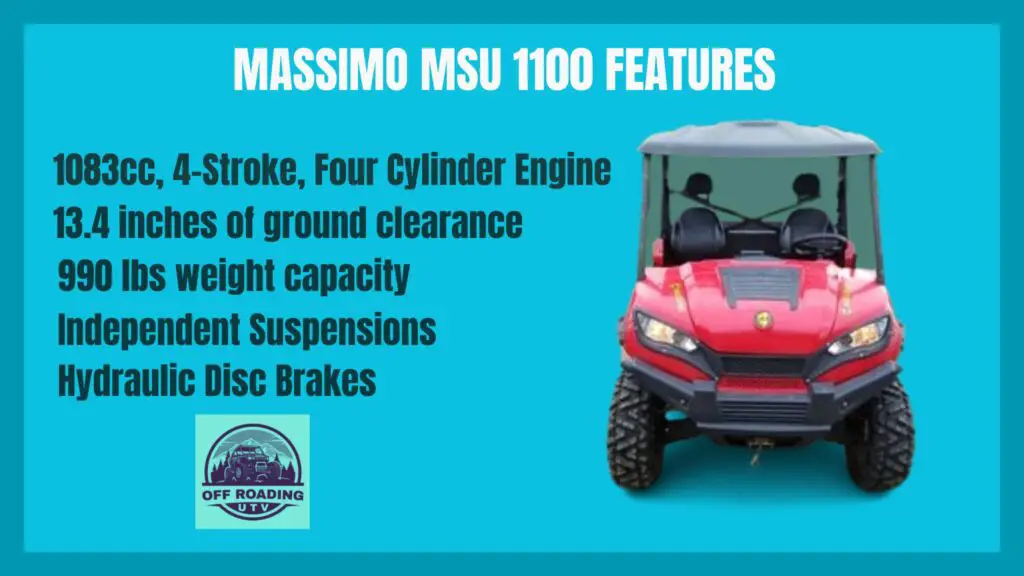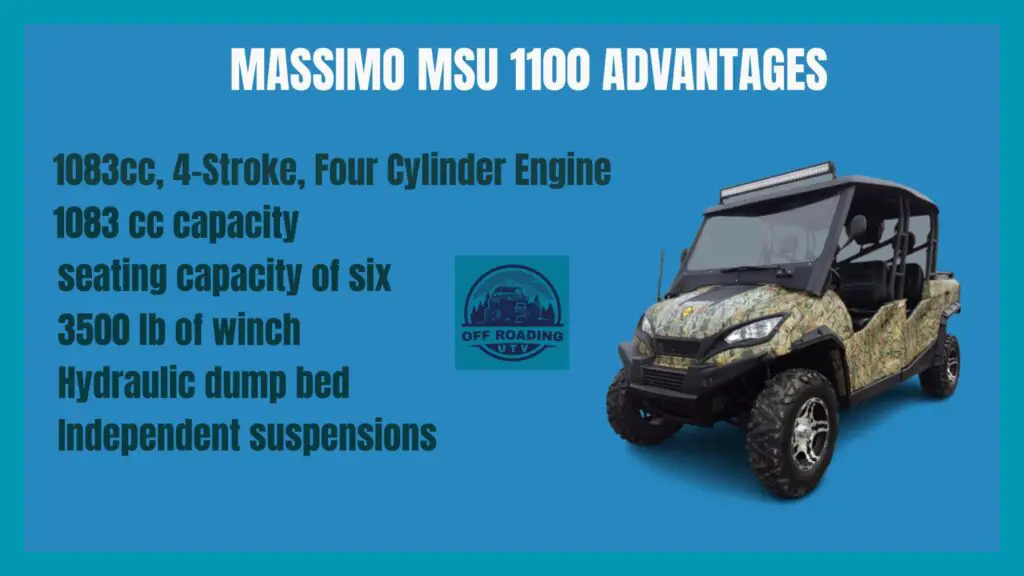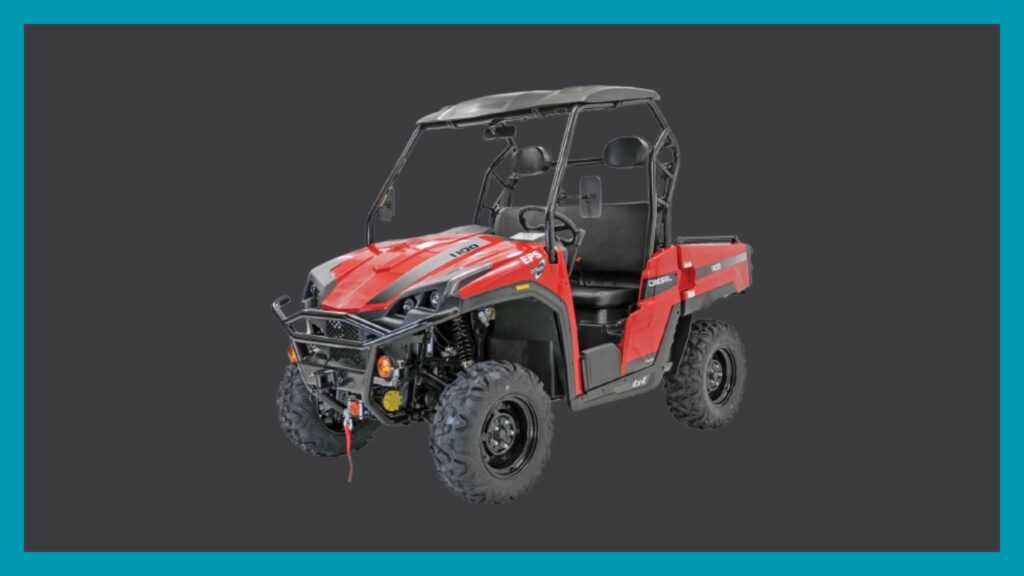Massimo MSU 1100 is great for its affordability, spacious seating, and offroad performance, praising it as a “nice unit” and a “great deal” for family outings. The massimo MSU 1100 is great for heavy duty work including the offroading, work, farming, and adventure as well.
However, the MSU 1100 is a heavy vehicle, poor with water crossings, muddy terrain, and snowy terrain, overheats in cabin due to engine placement and polycarbonate bed is a downside. It has issues including overheating, charging system failures, and engine starting difficulties, suggesting durability concerns that likely extend to the MSU 1100.
The Massimo MSU 1100 UTV is a robust, 6-seater UTV designed for both heavy work and recreational trail riding, with a powerful 1083 cc four-cylinder engine and a suite of features like independent suspension, a 3500 lb winch, and on-demand 4WD.
The heavy-duty frame and 13.4 inches of ground clearance, position the MSU 1100 as a good option for demanding tasks and group adventures.
The vehicle’s heavy 820 kg weight, cabin heat from its mid-rear engine placement, and limited parts availability due to its phased-out status are serious downsides of the MSU 1100.
Despite these drawbacks, the MSU 1100’s functionality can be enhanced through targeted solutions such as regular maintenance, such as cooling system checks, steering adjustments, and careful load management within the 990 lb dump bed capacity.
This guide explores the MSU 1100’s reviews, advantages, disadvantages, issues, and solutions to provide a real perspective on its performance and value as an off-road UTV.
What Positive Reviews Highlight Massimo MSU 1100 UTV Performance?
Positive user reviews highlight MSU 1100’s affordability, spacious seating, and trail-worthy performance, praising it as a “nice unit” and a “great deal” for family outings. A user review mentions the Massimo MSU 1100 as a nice unit, and a great deal.
The affordability of the MSU series is a plus. The user considered it for trail riding and is ready to trade LinHai 500 two seater for a 2014 Massimo MSU 1100 -6 six seater.
The Massimo MSU 1100 is 6 seater and 1083 cc as compared to 2 seater Linhai 500 cc. The reviews also suggest that the Massimo MSU 1100 UTV is good for trail riding, highlighting the importance of its features including 25 inch standard tires, independent suspensions and dual disc brakes.
The user further inquires about the massimo MSU 1100 and is interested in purchasing the windshield for MSU 1100.
What Negative Reviews Identify Massimo MSU 1100 UTV Weaknesses?
The negative massimo MSU 1100 user reviews mention the engine overheating, charging system failures, and engine starting difficulties, durability concerns, heavy 820 kg weight, and limited parts availability.
A review mentions that, user bought a 2014 Massimo 1100 and had 27 drive hours on it. The vehicle started showing the check engine light. The user does not see any error code, just a check engine light shows up. The user went to a massimo shop but it didn’t solve the problem. This raises concerns about the electrical system of the Massimo MSU 1100.
The massimo MSU series have many concerns including the issues with the charging system, engine not starting, engine overheating. It suggests that these problems are prominent in this model also.
What are Key features of Massimo MSU 1100 UTV?
Key features of massimo MSU 1100 include 1083 cc engine, 13.4 inches of ground clearance, 990 lbs weight capacity, 6 seater capacity, automatic CVT transmission and hydraulic disc brakes.

These are the detailed specifications of MSU 1100 UTV.
| Category | Specification |
| Engine Type | 4-Stroke, Four Cylinder |
| Displacement | 1083cc |
| Cooling System | Liquid Cooled |
| Fuel System | Electronic Fuel Injection (EFI) |
| Transmission | Automatic CVT with High/Low/Neutral/Reverse |
| Drivetrain | Shaft Drive, On-Demand 2WD / 4WD |
| Front Suspension | Independent Dual A-Arm with Anti-Sway Bar |
| Rear Suspension | Independent Dual A-Arm with Anti-Sway Bar |
| Front Brakes | Dual Ventilated Hydraulic Disc |
| Rear Brakes | Dual Ventilated Hydraulic Disc |
| Front Tires | AT 27 x 9-14 |
| Rear Tires | AT 27 x 11-14 |
| Ground Clearance | 13.4 inches |
| Maximum Weight Capacity | 990 lbs |
| Winch | 3500 lbs Winch Included |
| Fuel Capacity | 9.3 gallons (35.0 liters) |
| Overall Dimensions | 142.9″ L x 64.6″ W x 83.9″ H |
| Curb Weight | 711kg/820kg |
| Seating Capacity | 2 Persons/6 persons |
| Lighting | LED Headlights & Taillights |
| Dashboard Display | Digital Display |
| Extras | Roof, Windshield, Side Mirrors, Turn Signals |
What Advantages Enhance Massimo MSU 1100 UTV Functionality?
The main advantages of the Massimo MSU 1100 are its 4 cylinder engine which is unique in powersports, the 1083 cc capacity, seating capacity of six, 3500 lb of winch, hydraulic dump bed, independent suspensions.

The MSU 1100 comes with a power steering which eases the maneuver. The motor of the MSU 1100 is quiet. These all features offer an advantage to MSU 1100 UTV in terms of functionality, productivity, capabilities.
The 1100 cc engine is a very powerful engine as compared to other models in the class such as MSU 600, 850. The on demand 4WD and 2WD enhance the control of the vehicle power. The 6 person seating capacity gives massimo MSU 1100 an edge over the other UTVs as most of the UTVs are 2 or 4 seater in this series. The vehicle is pretty heavy and great for heavy duty tasks with 1200 lbs cargo capacity.
What Disadvantages Limit Massimo MSU 1100 UTV Performance?
The main disadvantages of the MSU 1100 are its high weight limiting agility and power usage, overheating in the cabin, delay in the operation due to warm up time, limited information and parts availability as it is an old series and has been phased out.

The dry weight of massimo MSU 1100 is 820 kg, while this heavy weight limits the high engine power of 1100 cc, which reduces the agility of the vehicle. The users have reported overheating issues within the cabin, as the engine is placed mid-rear of the vehicle.
The massimo MSU manual mentions that excessive heat builds up if the vehicle is operated at full throttle within the first three hours of vehicle usage. The msu 1100 cannot be operated immediately after starting, it needs time to warm up, which delays the operation.
Off Roading on hills is limited as massimo 1100 cannot be operated on terrain having slope more than 15 degrees and in fast flowing water. MSU 1100 is an old UTV, limiting its part availability. The information about the Massimo MSU 1100 related issues is not readily available, the parts are hard to make available.
How Does Massimo MSU 1100 UTV Compare to Massimo MSU 450 UTV?
The Massimo MSU 1100 is significantly higher in standard features, including the four cylinder, 1100cc engine, 1200 lb towing capacity, 3500 lb winch, 13.4 inch ground clearance, 9.3 gallons fuel capacity, 6 person seating capacity as compared to the MSU 450 which has single cylinder, 450cc engine, 11 inch ground clearance, 800 lbs towing capacity, 3.4 gallons fuel capacity, 2 person seating capacity.

Massimo MSU 1100 is almost 500 kg heavier than that of the Massimo MSU 450. The engine of Massimo MSU 1100 is more than twice as powerful as that of MSU 450. The MSU 1100 is made for heavy work, while the MSU 450 is for light duty work. Here are the detailed specifications of the MSU 1100 and MSU 450.
| Category | Massimo MSU 1100 | Massimo MSU 450 |
| Engine Type | 4-Stroke, Four Cylinder | 4Stroke, Single Cylinder, SOHC |
| Displacement | 1083cc | 352cm |
| Cooling System | Liquid Cooled | Liquid-Cooled |
| Fuel System | Electronic Fuel Injection (EFI) | Electronic Fuel Injection (EFI) |
| Transmission | Automatic CVT with High/Low/Neutral/Reverse | Automatic CVT with High/Low/Neutral/Reverse |
| Drivetrain | Shaft Drive, On-Demand 2WD / 4WD | Shaft Drive, On-Demand 2WD / 4WD |
| Front Suspension | Independent Dual A-Arm with Anti-Sway Bar | Independent suspension |
| Rear Suspension | Independent Dual A-Arm with Anti-Sway Bar | Independent suspension |
| Front Brakes | Dual Ventilated Hydraulic Disc | Hydraulic Disc |
| Rear Brakes | Dual Ventilated Hydraulic Disc | Hydraulic Disc |
| Front Tires | AT 27 x 9-14 | 25X8-12 |
| Rear Tires | AT 27 x 11-14 | 25X10-12 |
| Ground Clearance | 13.4 inches | 11 inches |
| Maximum Weight Capacity | 990 lbs | 450lbs |
| Winch | 3500 lbs Winch Included | – |
| Fuel Capacity | 9.3 gallons (35.0 liters) | 3.4 gallons |
| Overall Dimensions | 142.9″ L x 64.6″ W x 83.9″ H | 47.1″ L x83.1″ W x44.8″ H |
| Curb Weight | 711kg/820kg | 315 kg |
| Seating Capacity | 2 Persons/6 persons | 2 person |
| Lighting | LED Headlights & Taillights | LED Headlights & Taillights |
| Dashboard Display | Digital Display | Digital Display |
| Extras | Roof, Windshield, Side Mirrors, Turn Signals | Roof, Windshield, Side Mirrors, Turn Signals |
What Issues Affect Massimo MSU 1100 UTV Operation?
The main issues with Massimo MSU 1100 operation are excessive engine heat and noise, poor durability of the polycarbonate bed, and difficulty in steering.
How Does Engine Heat Impact Massimo MSU 1100 UTV Reliability?
The engine of the MSU 1100 is placed in a mid-rear position within the UTV. This helps to balance the weight of the vehicle. However, the engine below the rear seats makes the cabin heated when the vehicle is operated.
The excessive heat builds up in the engine and radiates to the cabin causing discomfort to the rider, passengers, and in turn making the vehicle difficult to operate. The overheating engine affects other parts and electrical circuits of the vehicle leading to malfunction.
This damage to the vehicle parts, and discomfort in operation, significantly affects the long term reliability of MSU 1100.
How Does Steering Effort Challenge Massimo MSU 1100 UTV Handling?
Massimo MSU 1100 is a heavy vehicle which is hard to handle on tight turns. The MSU 1100 comes with electronic power steering which helps to handle vehicles.
However, the vehicle is not as agile as small UTVs, thus it requires steering effort when you are carrying multiple passengers or any cargo/load. The immediate turns can be risky on high speeds at this vehicle, and require high effort.
How Does Polycarbonate Bed Durability Affect Massimo MSU 1100 UTV Safety?
The MSU 1100 has the polycarbonate bed to keep UTV light weight, which is durable for long term and can handle heavy loads without any cracks. However the polycarbonate beds are prone to scratches. The MSU 1100 dump bed can get scratched, due to sharp or heavy objects.
These scratches accumulate over time, and damage the dump bed. The polycarbonate beds undergo thermal expansion, which affects their fit. The scratched dump bed over time, needs replacement or coating. The bed can handle the load securely.
But the bed does not have any safety net, which can cause material to shift or fall out of the bed, posing hazards to the driver and others nearby. The repeated impact of material on off-road terrains, can cause the polycarbonate bed to damage over long term, which ultimately causes issues with safety of the vehicle during driving.
What Solutions Improve Massimo MSU 1100 UTV Performance?
The specific solutions which improve the Massimo MSU 1100 UTV performance include regular maintenance, such as cooling system checks, steering adjustments, and careful load management within the 990 lb dump bed capacity.

What Engine Cooling Solutions Enhance Massimo MSU 1100 UTV Reliability?
The engine cooling solutions such as routinely checking coolant levels, clearing the radiator, bleeding the system, and replacing worn cooling components (pump, thermostat, fan, sensor) prevent overheating, avoid thermal stress on engine parts, and ensure long‑term reliability of Massimo MSU 1100 UTV.
To check the coolant level, place the UTV on ground level and check the sight‑glass or reservoir. If the level is at or below the “MIN” mark, remove the cap and top up to “MAX” with the coolant mixture recommended by the manufacturer.
Do not use any unsuitable coolant that can’t manage heat effectively and it may corrode the system.
Another issue that interferes with cooling is the debris or mud in the radiator. Debris or mud in the radiator fins or water passages reduces heat transfer. Be cautious when removing the radiator cap, never remove the radiator cap when the engine or radiator is hot, wait for the system to cool and use a thick rag to slowly release any remaining pressure.
Inspect and clear any blockages regularly to ensure unobstructed airflow and coolant flow. Sometimes, air pockets can cause hot spots and overheating. If you suspect air intrusion after servicing, then release air and refill the cooling system so it’s fully liquid‑filled.
Leaking of the pump leads to less coolant levels, and ultimately overheating. Drain and replace with the approved type at service intervals. Replace the water pump if it shows signs of failure. If you see the stuck thermostat leading to temperature irregularities, then replace it with a new one.
The fan motor and activation switch are important when driving at low speeds or idling. If there are any issues with it, replace it. For overcooling, the owner’s manual recommends using a radiator cover or winter shroud to help the engine reach and maintain proper operating temperature.
What Steering Adjustments Optimize Massimo MSU 1100 UTV Handling?
Steering adjustments such as keeping steering parameters in check including freeplay, toe, caster, linkage wear, tire pressures and balanced preload, optimize the handling of Massimo MSU 1100.
To check if the vehicle steering is optimum or not, lightly turn the wheel left and right with the vehicle parked. You should see about 0.8–1.0 in (20–25 mm) of “dead” movement before the front wheels respond.
If there is excessive freeplay or strange noises, or the steering feels rough, the steering system should be inspected by an authorized dealer.
The proper toe alignment keeps the tires tracking straight and minimizes wandering which helps in proper steering. The manual recommends inspecting the toe periodically (especially after suspension work) and having your dealer adjust it whenever components are replaced.
The caster angle should be 8° to promote self‑centering and stable handling of MSU 1100 UTV.
The various joints in the steering wheels can become wear or loosen over time. Get them serviced time to time. The tire pressures also play an important role in the steering of the vehicle. Unequal pressures or worn tires upset steering feel.
For 27″ tires, maintain 14 ± 0.5 psi front and rear; for 26″ optional tires, 12 ± 0.5 psi. Replace tires when tread reaches 1/8″ (3 mm) to preserve consistent cornering grip.Always set left/right front spring preloads of suspension identically to keep steering geometry balanced.
What Bed Reinforcement Solutions Strengthen Massimo MSU 1100 UTV Safety?
The bed reinforcement solutions such as regular check of the MSU 1100 bed and its components, carrying loads below 990 lbs, avoiding aftermarket modifications strengthen the Massimo MSU 1100 UTV safety.
The Massimo MSU can carry a maximum 990 lbs of weight. It includes operator, passenger, and accessory weight. To ensure safety the vehicle maximum payload capacity should not be exceeded. The MSU 1100 manual does not recommend to carry or tow beyond that limit. Daily check for loosened, worn out bolts, and parts of the cargo bed.
There are no specific weld‑in plates, gussets, bed‑support bars or dealer‑approved reinforcing kits recommended by massimo, thus the unauthorized replacements, or modifications can lead to structural defects and affect the safety.
What Maintenance Practices Optimize Massimo MSU 1100 UTV Longevity?
The maintenance practices including the Daily Pre‑Ride Checks, Strict Break‑In Discipline, Engine Oil Care, Gearcase (Transmission) Oil, Air Filter Upkeep, CVT Clutch & Belt Maintenance, Cooling System Checks, Brake System Servicing, Spark Plug Replacement, Throttle Linkage Freeplay, Steering & Suspension Care, Tire Maintenance, Battery & Electrical, Cleaning & Storage, Post‑Immersion Protocoldaily pre-ride checks, a regular break-in check, routine replacement of engine-oil, air filters cleaning definitely optimize the MSU 1100 UTV longevity.
| Maintenance Practice | Schedule / Procedure |
| Daily Pre‑Ride Checks | Inspect brakes, steering freeplay, engine oil level, air filter, seat belts, brake fluid, tires, throttle, gearcase fluid, spark plug condition. |
| Strict Break‑In Discipline | First 10 h (or two fuel tanks), avoid full‑throttle/high speeds, moderate braking, vary RPM; change engine oil at 10 h or one month |
| Engine Oil Care | Check daily; maintain oil between dipstick marks; change oil & filter at 10 h (break‑in), then every 100 h or 6 mo using specified grade |
| Gearcase (Transmission) Oil | Check level monthly (25 h/250 mi); replace annually to protect gears & bearings |
| Air Filter Upkeep | Inspect & clean weekly; replace if damaged or clogged—running on a dirty filter accelerates engine wear |
| CVT Clutch & Belt Maintenance | Inspect belt & sheaves every 100 h (or yearly/1 500 km), ensure 10–15 mm droop; after water exposure, dry CVT per manual |
| Cooling System Checks | Keep coolant between MIN and MAX when cold; never remove cap hot—relieve pressure first; top up with recommended mix |
| Brake System Servicing | Daily: firm pedal feel & fluid level; Monthly: inspect pad wear, replace at 1 mm thickness; Bi‑annual: replace brake fluid |
| Spark Plug Replacement | Check every 100 h or 600 mi; maintain 0.9–1.1 mm gap and 20 Nm torque |
| Throttle Linkage Freeplay | Confirm 1.5–3 mm pedal freeplay periodically; prevents sticking or erratic idle |
| Steering & Suspension Care | Verify 20–25 mm steering‑wheel freeplay daily; lubricate suspension every 50 h or 6 mo; match shock preload left/right |
| Tire Maintenance | Maintain 14 ± 0.5 psi (27″) or 12 ± 0.5 psi (26″); replace tires at 3 mm tread depth |
| Battery & Electrical | Clean/test battery monthly; for >60 d storage remove battery, store dry, recharge monthly |
| Cleaning & Storage | Wash with mild soap, avoid direct CVT spray; for 60 d+ storage drain fuel, fog engine, elevate wheels, seal exhaust, lightly oil metal |
| Post‑Immersion Protocol | After deep water exposure: dry airbox, spark plugs, crankcase, CVT before restarting |
How Reliable Is Massimo MSU 1100 UTV Engine Performance
The Massimo MSU 1100 is reliable in specs, as this engine is 1.083 L, water‑cooled and 4‑stroke, however placed mid-rear leading to excessive heat accumulation and long term damage to the vehicle. The 1100 cc engine capacity is the highest in the MSU series.
The engine seems reliable with the specifications. The engine has four cylinders, liquid cooling with 850 ± 50 rpm, 9.5 : 1 compression. ignition is handled by a 12‑V electric starter and pressured‑spray lubrication. The engine is placed below the rear seats, to balance the weight and avoid the heat into the drivers cabin.
There are multiple issues with the massimo MSU engine overheating, and radiating heat in the cabin. This concerns the reliability of the engine over time, and damages electrical systems. This engine placement seems to be a downside.
But as far as the engine is considered for reliability, the engine is very powerful in comparison to other brands including honda, polaris, yamaha, massimo does compete well. However this is an old vehicle, so parts availability is a concern about massimo MSU engines.
Reliability is dependent on proper break‑in and adherence to maintenance intervals including daily oil‑level checks, 100 h oil/filter changes, and spark‑plug inspections at 100 h ensure consistent combustion and prevent wear .
Is Massimo MSU 1100 UTV a Worthwhile Off‑Road Investment?
Considering the features including 1083cc, water cooled engine, 990 lbs maximum weight capacity, heavy‑duty steel‑tube frame, double‑A‑arm independent suspension front and rear, and 340 mm (13.4 in) ground clearance, tubeless 27×9‑14 (front) and 27×11‑14 (rear) tires, Dual disc brakes, a 2.66:1 high‑gear CVT massimo MSU 1100 is worthwhile off-road investment.
For offroading, a vehicle should have a good engine power more than 500 cc, at least 12 inches of ground clearance, a tough and stable vehicle frame, comfortable suspension, efficient brakes. The Massimo MSU 1100 is designed exclusively for off‑road use, is a heavy‑duty steel‑tube frame, double‑A‑arm independent suspension front and rear, and 340 mm (13.4 in) ground clearance, tubeless 27×9‑14 (front) and 27×11‑14 (rear) tires for good traction .
Dual disc brakes, a 2.66:1 high‑gear CVT, and a factory‑installed roll cage with three‑point seat belts underscore its rugged build. This UTV has a 990 lb payload capacity which makes it further suitable for off-road use cases such as hunting. These all features make MSU 1100 worthwhile for off-roading.
How Does Massimo MSU 1100 UTV Perform on 15° Uphill Terrain?
The Massimo MSU 1100 performs well and tackles 15° Uphill Terrain if the proper procedures are followed. The maximum limit recommended for operating MSU 1100 is 15° of angle. Exceeding 15° risks traction loss, overheating, or rollover.
The Massimo MSU 1100 performs well on the 15° Uphill Terrain if the proper procedures are followed. The correct procedure to drive MSU 1100 on 15° Uphill Terrain is to select a straight line, maintain a steady, moderate throttle , and use forward gear only . At engine stall, gently brake, then shift to reverse and back down the slope under light brake pressure.
What Safety Features Protect Massimo MSU 1100 UTV Drivers?
The safety features including three‑point lap–shoulder seat belts, full steel‑tube cab frame, DOT‑compliant warning labels, keyed ignition interlock, dashboard of AWD mode, engine temperature, oil pressure, and fuel levels, dump‑resistant bench seat, and clear safety‑gear guidelines protect MSU 1100 drivers.
For driver safety, three‑point lap–shoulder seat belts for driver and passenger, is the most important safety feature. The safety warnings include various warning labels on the vehicle, the AWD mode, engine temperature, oil pressure, and fuel levels on the digital dashboard.
In the design, a full steel‑tube cab frame (though not ROPS‑certified), a keyed ignition interlock that prevents operation without proper preparation. Ergonomic pedals with built‑in return springs, a dump‑resistant bench seat, and clear safety‑gear guidelines (helmet, gloves, boots, goggles) make the system more safe for rider error and mechanical risk.
How Does Massimo MSU 1100 UTV Dump Bed Function with 990 lbs Capacity?
At 990 lbs capacity, massimo MSU dump bed functions properly with proper driving procedure. However, in practice the load should be lower than 990 lbs.

The rear cargo box of Massimo MSU 1100 has a total weight of 990 lb (450 kg) which includes (rider, passenger, accessories. This makes the MSU 1100 fall under the category of heavy duty UTVs. The dump bed is polycarbonate bed which is durable, but weaker than the other types of bed such as metal bed, dimond plated bed.Over 990 lbs, the bed can undergo breakage, it can cause the overloading, loss of traction. So it is wise to have weight below 990 lbs.
However at 990 lbs, the vehicle performs well and carries the load without any issues with proper driving procedures. Carrying such high load at higher speeds is not recommended. In practice, you simply load within that limit and manually tip out materials; any bed‑reinforcement kits must be dealer‑approved to preserve warranty and frame strength.
What Maintenance Tips Extend Massimo MSU 1100 UTV Lifespan?
The important maintenance tips that extent MSU 1100 lifespan includes sticking to the maintenance chart, pre-ride checks, regular oil changes, clutch inspections, replacing the filters, brake fluids.
The maintenance of the vehicle should be done as per maintenance chart. The maintenance chart of MSU 1100 includes daily pre‑ride checks (brakes, steering, oil, filters), oil & filter changes every 100 h (3.6 L engine oil), annual transmission fluid swaps, and CVT belt/clutch inspections at 100 h with correct belt droop (10–15 mm) .
Clean or replace the dry‑element air filter weekly, purge air from the cooling system and top off coolant, bleed and renew brake fluid bi‑annually, and follow the CVT‑drying procedure after water crossings.
| Item | Hours | Calendar | Miles (Km) | Remarks |
|---|---|---|---|---|
| Steering | — | Daily | — | Check daily before driving. Adjust as needed. |
| Tires | — | Daily | — | |
| Brake fluid level | — | Daily | — | |
| Brake system | — | Daily | — | |
| Brake pedal travel | — | Daily | — | |
| Wheels/fasteners | — | Daily | — | |
| Frame fasteners | — | Daily | — | |
| Engine oil level | — | Daily | — | |
| Engine oil change (break-in) | 25 | 1 M | — | Perform a break-in oil change at one month |
| Engine oil change | 100 | 6 M | — | |
| Air filter, main element | — | Weekly | — | Inspect; replace as needed |
| Brake pad wear | 10 | Monthly | 100 (160) | Inspect periodically |
| Idle speed | — | — | — | Check; adjust as needed |
| Front Suspension | 50 H | 6 M | 500 (800) | Lubricate |
| Rear Suspension | 50 H | 6 M | 500 (800) | Lubricate |
| Spark plug | 100 | 12 M | 600 (1000) | Inspect; replace as needed |
| Front wheel bearings | 100 H | 12 M | — | Inspect; replace as needed |
| Shift Linkage | 50 H | 6 M | 500 (800) | Inspect, lubricate, adjust |
| Battery | 25 | Monthly | 250 (400) | Check terminals; clean; test |
| Toe adjustment | — | — | — | Inspect periodically; adjust when parts are replaced |
| Headlight aim | — | — | — | Adjust as needed |
| Choke | 10 | Monthly | 100 (160) | Check for proper operation; see dealer for adjustments |
| Main gearcase oil | 25 | Monthly | 250 (400) | Inspect level; change yearly |
How Does Massimo MSU 1100 UTV Perform in Mud with 13.4‑inch Clearance?
The 13.4 inch ground clearance of the MSU 1100 helps vehicles to resist bottoming out in most muddy trails. The MSU 1100 can be driven through the mud with mud levels below the floor of the vehicle. However, mud is slippery terrain.
Thus it is important to approach slowly, maintain momentum, avoid abrupt steering or braking. Through the mud, the water can enter the airbox of the vehicle. If water enters the airbox or CVT, follow the dehydration steps before resuming to preserve belt life and engine health .
What Customer Service Experiences Shape Massimo MSU 1100 UTV Ownership?
The users mention that massimo has good initial customer service including the 6 months warranty, parts replacement, and fixing issues with the system.
However some users suggest issues with the follow up. The servicing is recommended to be done by the professional dealers, so the owner’s responsibility is to contact the dealer for any issues. It is more of a dealer’s responsibility .
Massimo MSU 1100 has a 6 months warranty for the vehicle. However, massimo has several conditions for it. All warranty work and technical services must be performed by an authorized Massimo dealer in your purchase country. If you travel, any local dealer can provide warranty upon proof of purchase .
For out‑of‑country use, pre‑approval is required or coverage lapses. Dealer support is recommended after water immersion, suspension service, or any rollover to inspect for hidden damage.
The sealed battery and modular electronics makes it more of a dealer responsibility and less owner’s responsibility. The owner’s manual provides all important information about the services and maintenance.
The massimo MSU 1100 is good for heavy duty work including the offroading, work, farming, and adventure. Positive user reviews highlight four advantages including affordability, spacious seating, and good offroad performance.
The heavy-duty frame and 13.4 inches of ground clearance, is an adventure for the MSU 1100 as a good option for demanding tasks and group adventures. The main six disadvantages are overheating, charging system failures, engine starting difficulties, heavy weight, limited parts availability and poor customer service.
The five maintenance tips that help to increase lifespan of MSU 1100 are regular maintenance, tire pressure check, cooling system checks, steering adjustments, and careful load management within the 990 lb dump bed capacity. The 990 lbs capacity and 73 hp is great for off-road use.
The MSU 1100 is a beast on any trail! Curious about other models? Learn more about the Massimo MSU 850 for your next big adventure.
Subscribe for Our Latest Posts! Thank you!
 Massimo UTV & Side-by-Side Massimo UTV & Side-by-Side
Massimo UTV & Side-by-Side Massimo UTV & Side-by-Side







